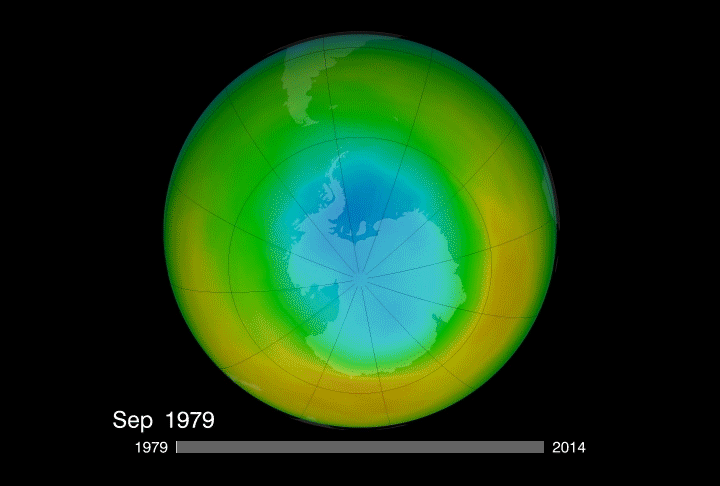News•October 30, 2015
This Year's Ozone Hole is the Fourth-Largest on Record
The ozone hole, an environmental problem often associated with the 1980s, is still a clear and present issue more than 30 years later. Despite efforts to clean up the stratosphere of ozone-depleting chemicals, this year’s ozone hole minimum bottomed out at the fourth lowest on record.
The ozone hole this year grew to a size of 10.9 million square miles, which is larger than the continent of North America. It’s a 1.3 million square miles bigger than last year’s size, and is the fourth largest on record since 1991.
An animation showing the ozone hole in September, the month it reaches its minimum, from 1979-2014.

This year the hole formed later and lasted two weeks longer than usual, leading to almost 100 percent ozone depletion. While ozone-depleting chemicals are still playing a role, natural factors, such as stratospheric circulation, also helped drive this year’s widespread thinning.
“During September we typically see a rapid ozone decline, ending with about 95 percent depletion in that layer by October 1,” Bryan Johnson, a researcher at the Earth System Research Laboratory, said in a press release. “This year the depletion held on an extra two weeks resulting in nearly 100-percent depletion by October 15.”
While the ozone hole is a stratospheric phenomenon, it can also stir winds in the lower levels of the atmosphere, which in turn affect Antarctic sea ice. Other factors, such as El Niño, also affect the region’s ice and could be responsible for it not hitting a record maximum this year as it has in recent years. The ozone hole could also be reducing the Southern Ocean’s ability to stash carbon.
Harmful chemicals, known as chlorofluorocarbons, are the main culprits and cause the ozone to get thinner and thinner. The hole first received public attention in the 1980s and spurred government action to take ozone-depleting chemicals, widely used as refrigerants, out of rotation.
The 1987 treaty to reduce these chemicals, dubbed the Montreal Protocol, has widely been viewed as a successful global response to an environmental problem. It also had the unfortunate side effect of creating a rise in hydrofluorocarbons — a potent greenhouse gas — as alternative coolants.
Governments are now trying to figure out how to phase them out in order to slow down global warming.
You May Also Like:
El Niño Could Push CO2 Permanently Above Milestone
Texas, California Lead Nation in Carbon Emissions
Climate Change is Decimating Cod in the Gulf of Maine
Paris Agreement Could Put Leash Around Global Warming